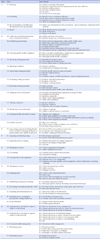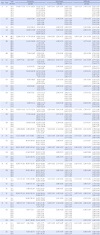Abstract
Purpose
The aim of this study was to analyze the tasks of managers who were working in the Customized Visiting Health Services (CVHS) and to prioritize analyzed tasks according to performance frequency, perceived importance, and difficulty.
Methods
Job analysis method by Hartley (1999) was used for task analysis and performance frequency, perceived importance, and difficulty were used for prioritize as criteria. A total of 85 managers in the CVHS of public health centers nationwide were recruited through e-mail and mail survey. Using SPSS/WIN 15.0, descriptive statistics, such as frequency distribution, means, median, and standard deviation, were conducted to examine each subject's general characteristics, the frequency, importance, and difficulty of the tasks as well as to prioritize the each task.
Results
The job description of the managers revealed 12 duties, 35 tasks, and 104 task elements. Of the 85 managers, 84.8% were classified as nurses, 40.5% were home health care specialists, and 32.9% were social workers. Their coretasks were management of client cases, budget management, and management of work performance and quality assurance.
Figures and Tables
References
1. American Nurses Association. Home health nursing: Scope and standards of practice. 2007. Maryland: Nurses Books Org.
2. Denton M, Zeytinoglu IU, Davies S, Lian J. Job stress and job dissatisfaction of home care workers in the context of health care restructuring. Int J Health Serv. 2002. 32(2):327–357.
3. Gomby DS, Larson CS, Lewit EM, Berman RE. Home visiting: Analysis and recommendations. Future Child. 1993. 3(3):6–22.
4. Han S, Lee S. Statistical analysis of nursing and health care. 2004. Seoul: Hyunmoonsa.
5. Hartley DE. Job analysis at the speed of reality. 1999. MA: HRD Press.
6. Kang SR, Park JH. Concept analysis of the role in nursing profession. J Korean Acad Nurs Adm. 2002. 8(3):431–438.
7. Kim HS, Kim SK, Kang JS. The study on education course for exercise instruction for dimentia by DACUM job analysis. J Korean Gerontol Soc. 2008. 28(2):357–375.

8. Kim MS, Song JH, Kim BH, Lee SH. A study on the job analysis for new nurse. J Educ Eval Health Prof. 2004. 1(1):15–26.

9. Kim KS, Park YH, Lim NY. Task analysis of the job description of gerontological nurses practitioners based on DACUM. J Korean Acad Nurs. 2008. 38(6):853–865.
10. Kweon HN. Direction for customized visiting health service. Paper presented at the meeting of Ministry of Health and Welfare and Representative of FMTP. 2010. 05. Seoul.
11. Ministry of Government Legislation. Act on community health (1995). 2011. Retrieved July 22, 2011. from http://www.mole.go.kr.
12. Ministry for Health, Welfare and Family Affairs. 2009 Customized visiting health service guidebook. 2009. Seoul: Author.
13. Ministry for Health, Welfare and Family Affairs & Management Center for Health Promotion. 2008 evaluation on customized visiting health service. 2009. Seoul: Author.
14. Ministry for Health, Welfare and Family Affairs. 2010 Customized visiting health service guidebook. 2010. Seoul: Author.
15. Oh PJ, Kim IO, Kim YH, Sin SR, Lee KS, Han SJ. Task analysis of Korean geriatric care manager. J Korean Acad Nurs. 2006. 36(5):770–781.
16. Robotham A, Sheldrake D. Health visiting: Specialist and higher level practice. 2000. Edinburgh, London, NY, Philadelphia, St Louis, Sydney, Toronto: Churchill Livingston.
17. Ryu HS, Park ES, Park YJ, Han KS, Lim JY. A workload analysis of a visiting nursing service based on a health center in seoul. J Korean Acad Nurs. 2003. 33(7):1018–1027.
18. Song MS. The optimal workload for the visiting nurses of customizing health care estimated by job analysis. 2009a. Suwon: Management Center for Health Promotion.
19. Song MS. Role of manager in the customized visiting health service. Paper presented at the meeting of the field management training program for customized visiting health service. 2009b. 02. Seoul:
20. State of Rhode Island Department of Health. Home visiting program manager. 2011. Retrieved September 21, 2011. from http://www.health.ri.gov/jobs/201108homevisitingprogrammanager.pdf.
21. Virginia Home Visiting Consortium. Home visiting: Job description of key personnel. 2011. Retrieved September 21, 2011. from http://homevisitingva.com/wp-content/uploads/2011/03/Attachment-1-job-descriptions.pdf.
22. Wasik BH, Bryant DM. Home visiting: Procedures for helping families. 2001. 2nd ed. CA: Sage.
23. Whang NM, Park JH. Policy directions for establishment and expansion of home nursing care in Korea. 2001. Seoul: Korea Institute for Health and Affair and Ministry of Health & Welfare.
24. Whang MJ, Cho SJ, Cho YH, Park IH, Ko JH, Choi HJ, et al. Community Health Nursing-I. 2010. 5th ed. Seoul: Hyunmoonsa.
25. Yoon KS. Hartley DE, editor. Job analysis at the speed of reality. 2003. Seoul: Hakjisa;(Original work published 1999).
26. Yoon TH. The proposal of policies aimed at tracking health inequalities in Korea. J Prev Med Public Health. 2007. 40(6):447–453.




 PDF
PDF ePub
ePub Citation
Citation Print
Print






 XML Download
XML Download